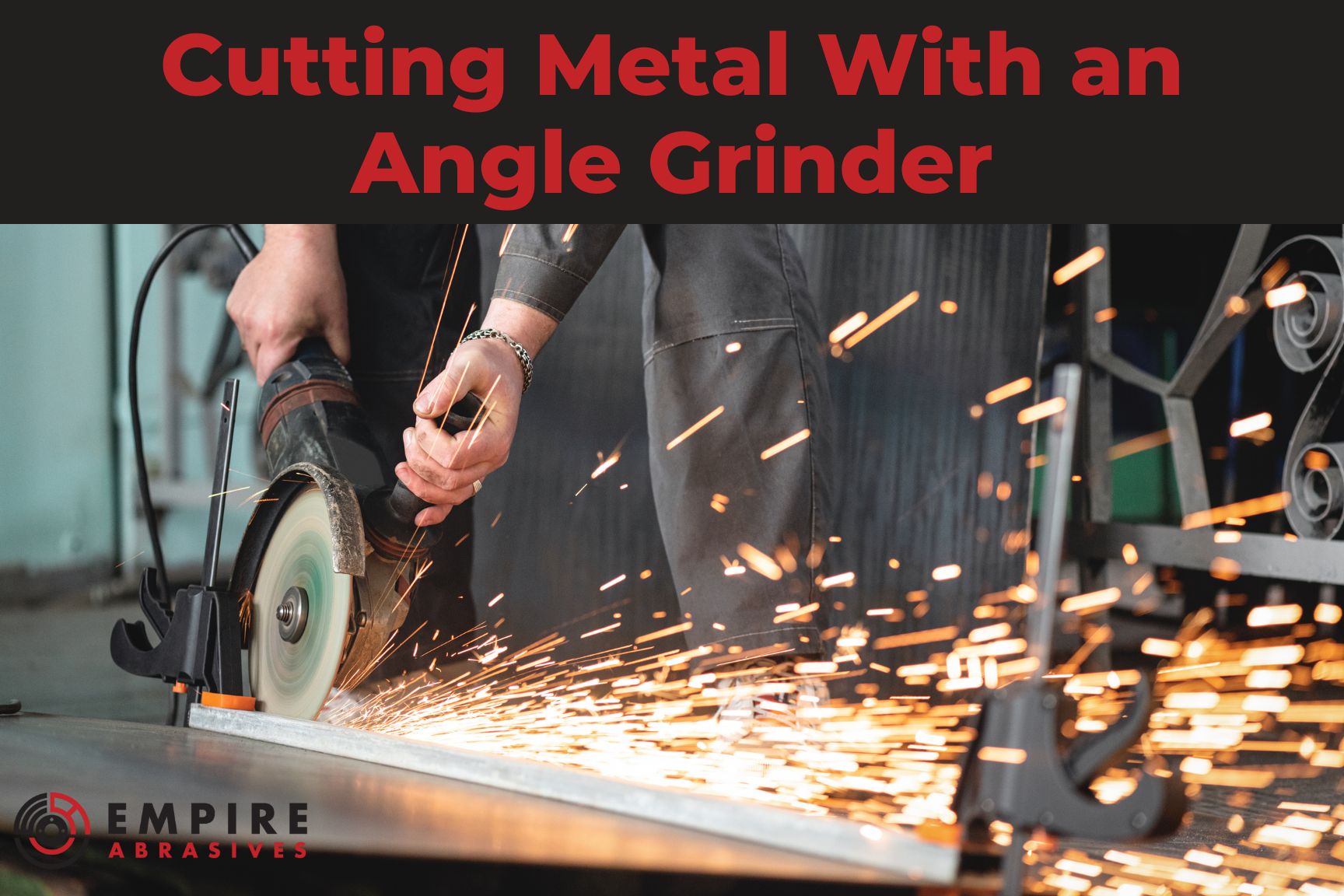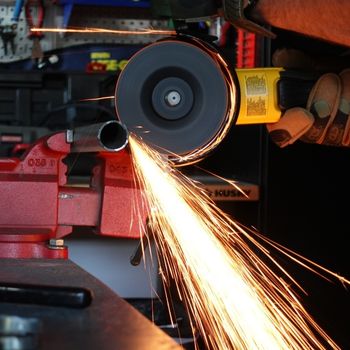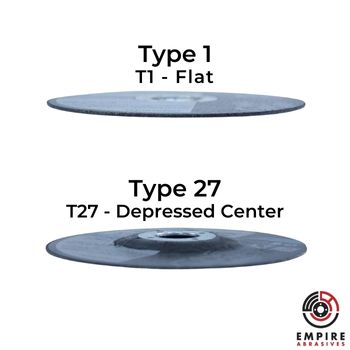
Angle grinders are excellent tools for cutting metal. However, there are a few things that you need to know before cutting metal with an angle grinder so you can stay safe and get the best results.
To ensure an angle grinder meets your metal-cutting needs, we’ll explore the purpose of an angle grinder, how to choose the right cutting disc, how to use an angle grinder to cut metal, and grinder safety.
Why Use an Angle Grinder to Cut Metal?
Angle grinders (also called “disc grinders,” “right angle grinders,” or “side grinders”) are excellent tools for cutting both hard and soft metals. With the right grinding or cutting disc, they can perform various metal-related tasks, including cutting.
Because you can adjust angle grinders for precise cutting, professionals often use them in their preparatory work. These machines are excellent options for cutting metal pipes, cutting sheet metal, and cutting through metal in bolts quickly and cleanly.
Industries and hobbies that utilize disc grinders with cutoff discs for their metal-cutting needs include:
- Knifemaking: Both experienced and amateur bladesmiths use cutoff discs for cutting metal for blades.
- Auto body work: Cutting metal for individual car parts is easy with an angle grinder.
- Welding: Welders probably use these machines more than any other tool except their welding machines since they’re able to cut specific angles for their projects.
- Plumbers: Plumbers are able to cut through pipes easily and at the precise angles they need.
- Tiling: Tilers can use the machine to easily cut metal tiles to the right size and angle for metal tiling projects.
Many industries and hobbyists use angle grinders for their cutting because they are versatile and can have other uses besides just cutting metal with the proper discs. Once someone finishes cutting, they can switch to another disc for other purposes.
However, while angle grinders are powerful tools for cutting metal, they are not suitable for larger-sized projects. Luckily, there are plenty of other tools for cutting metal if an angle grinder won't work.
Choosing the Right Cutoff Disc
When you are looking for a cutoff disc for a metal-cutting job, there are a few things that you should note to ensure that you’re choosing the right disc for the job. To cut metal, you will need an abrasive cutoff disc (sometimes called a cutoff wheel).
Which Metal Disc Is Best for Cutting?

When you use a cutoff disc not rated for the type of metal you need to cut, you won’t get the best results. The abrasives embedded in each wheel work best with specific metals.
For example, if you try to cut softer, non-ferrous metals with low melting points like aluminum, brass, copper, and bronze with cutoff wheels that get too hot, you can end up damaging the metal or end up with burr formation. You’ll find that aluminum cutting discs contain aluminum oxide and silicon carbide abrasives that remain cooler and are better for cutting softer metals.
It’s possible to use a multi-purpose disc that works on several metals. However, they are not as efficient for cutting as discs rated for your specific metal.
Disc Composition
Look for cutting discs made with resinoid-bonded abrasives. Resinoid embeds the abrasive materials into the wheel. So, the sharp grains continue to be exposed as the disc wears, extending its cutting life.
Durability
The most durable cut wheels use fiberglass as a reinforcement to increase wheel strength and resist breaking when you need to apply extra pressure.
Disc Thickness
Cutting disc thicknesses range from 0.04 in (1.02 mm) to 0.09 in (2.38 mm).
Ultra-thin cutoff discs are 0.04 in (1.02 mm) or 0.045 in (1.14 mm) thick. These thinner discs cut metal faster with less waste.
Meanwhile, thicker discs remove more metal during a cut but last longer and are easier to use without needing to rock the machine as much when making the cut.
You can use thicker discs that are 1/16 in (1.57 mm) and above for cutting heavier metals. However, keep in mind that they cut slower, produce more heat, and may end up discoloring the metal.
How Deep You Need To Cut
Since angle grinders are handheld and have a limited disc size, there’s a limitation on how deep they can cut. The guard will prevent you from being able to cut deeper than 2.75 in (69.85 mm) deep with a standard 4 ½ inch angle grinder.
Disc Type
here are several types of discs rated for cutting metal with an angle grinder. The one you use depends on different cutting needs, metals, and environments.
 Type 1 Cutting Discs
Type 1 Cutting Discs
Type 1 (T1) discs are flat across the entire surface of the disc, including the center. This wheel is generally used for all-purpose cutting.
The downside to using a T1 cutoff disc is that they expose the locking-nut center of the machine, so it’s not as easy to get a flush cut in some cases. They also mount close to the guard, which makes visibility more difficult. They are also prone to shattering when flexed too much.
Type 27 Cutting Discs
Type 27 (T27) discs are flat across the entire surface of the disc except for the center where it has a depression. Having a valley in the center of the wheel allows you to get closer to and flusher with the metal.
For example, if you need to cut a bolt, it’s easier to cut at a 90-degree angle when there’s an indention in the middle preventing interference from the locking-nut center connection of the machine.
However, they are more expensive and have more limited cutting abilities.
How to Cut Metal With an Angle Grinder
Following these steps to cut metal with angle grinders safely and efficiently:
1. Choose the Best Disc
Before you get started, you need to make some assessments to choose the right disc:
- Metal type: Choosing the right disc for your metal rather than an all-purpose disc will deliver better results.
- Cutting depth: You will need to choose the right disc size to match the depth you need to cut without the guard interfering.
- Type of cut: If you need a more flush cut, a T27 disc will work better than a T1.
2. Inspect Your Machine and Cutting Wheel
While the machine itself can take a beating, it’s important to ensure that the center nut and thread are not damaged so that the wheel isn’t in danger of flying off mid-cut.
You also need to check the cutting wheel to ensure it’s not broken or corroded. If it has any cracks or corrosion, you run the risk of having it shatter while you’re using it, which can hurt you and ruin your metal project.
3. Attach the Disc to the Grinder
To secure a flat, T1 disc to the grinder, make sure the flat side of the nut is downward against the machine.
On the other hand, if you’re using a depressed, T27 disc, the protruding part of the nut should be face down. You also need to ensure that it’s a snug fit.
4. Secure Your Metal
The metal that you intend to cut needs to be clamped securely on one end so that it stays steady while you cut it.
You also need to ensure that the piece of metal that you intend to cut off has a space to fall freely after it’s cut off the clamped piece of metal.
5. Put on Your Personal Protective Equipment
Personal protective equipment (PPE) can help prevent accidents. Always wear safety glasses and earplugs at a minimum.
6. Inspect the Rotation
You’ll want to turn on the machine and ensure it’s functioning properly before you begin the cutting process. If you have fastened the disc correctly to the machine and it’s not warped, the wheel should rotate smoothly without any inconsistencies in rotation.
7. Ensure Your Environment Is Ready for Cutting
You should also ensure there are no dangerous objects nearby or above you. For example, you don’t want to cut underneath electrical wires or near trash that could ignite with the sparks from your cutting.
8. Start Cutting
Ensure that you are holding the machine with both hands with the guard facing your body. Position the machine so that you don’t need to cross your arms over each other during the cutting process.
9. Use The Right Techniques
Using the right techniques when cutting prevents breaking the wheel:
- Connect the blade with the metal at a 90-degree angle.
- Don’t try to cut too quickly.
- Move the wheel slowly while applying moderate pressure.
- Let the blade do the cutting for you, and never use excessive pressure.
- Watch the metal as you cut.
- Move the blade from one end to the other, making complete cuts as you go.
10. Complete the Cut
Be prepared for a slight kickback when your cut comes to an end. To prevent having too much kickback, you should decrease the amount of pressure you’re applying to the machine as you reach the end of the metal cut.
Angle Grinder Safety
Safety is essential with any power tool. However, any tool that can cut through metal at lightning speeds has the potential to be very dangerous. Thus, it’s imperative to take safety precautions when using an angle grinder.
Using the Correct Blades
Always use blades that are rated for angle grinders. Never use metal-cutting circular saw blades instead. The types of blades that work on power saws have base shoes that pull the metal toward the base while you cut.
Utilizing the Safety Guard
Always ensure that the safety guard rather than the cutting wheel is facing your body when cutting metal with an angle grinder.
Never remove the safety guard. It’s there to keep you safe.
Keep in mind that you can rotate the safety guard to fit your cutting position to keep you safer.
Ensuring Workspace Safety
When you’re using a grinding wheel, the resulting sparks can reach up to 1800 F (982 C). So, you have to be sure that nothing in your workspace can ignite when the sparks fly, including:
- Wood
- Sawdust
- Cardboard
- Paper
- Trash
- Fuel
- Chemicals
- Power cables
Use in a Ventilated Area
The metal-cutting process produces flying metal pieces, sparks, and fumes. So, it’s imperative to use your grinder in an environment where it’s possible to open windows and doors.
If there’s a breeze blowing through, be sure to cut in a position where the sparks are blowing away from you.
Wear Personal Protective Equipment
The following personal protective equipment (PPE) is recommended:
- Safety glasses: Flying pieces of metal can injure or blind your eyes.
- Earplugs: The machine is far too loud to use without ear protection.
- Face shield: Safety glasses are a minimum requirement, but a full face shield is a better option since it can protect your entire face from flying metal and sparks.
- Leather apron: A leather apron is optional but can protect your clothes and body.
- Tight, sturdy gloves: Gloves can provide a better grip. However, you should avoid wearing loose gloves that can catch in the grinder.
Wear the Right Clothing
Paying attention to the clothing you wear while cutting metal is also important. It’s best to wear natural-fiber clothing without any tears or frayed edges.
Tuck your shirt into your pants and remove any jewelry or earphones that can get caught in the machine.
Also, avoid wearing clothing with synthetic fibers, which can be prone to melting or catching fire. A welding jacket or fire-resistant shirt can also help.
Have a Fire Extinguisher Nearby
In the event that the sparks catch something on fire, it’s important to always keep a fire extinguisher within easy reach. You should have a powder extinguisher rated for class A, B, and C fires.
